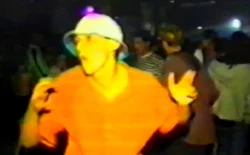Available on: Awesome Tapes From Africa
In 2005, an American ethnomusicology student named Brian Shimkovitz started a blog called The Hiplife Complex after spending three years researching one of Ghana’s youngest (and most youthful) musical styles and movements.
Hiplife is often regarded a fusion of highlife – a collusion of big band jazz and brass band styles infused with key alleles from the DNA of the African and Caribbean diasporas – with the production structures of American hip-hop and rap. The Hiplife Complex was not an attempt to deconstruct the history of hiplife culture, but rather was a simple, earnest document of Shimkovitz’s enthusiastic absorption of what he goes on to dub “the most visible, vital, and controversial movement in Ghanaian music probably ever.”
Shimkovitz’s research led him to a one-year stay in Ghana (plus additional travels to Mali, Ethiopia and elsewhere) filming, recording, and transcribing hours upon hours of material. During his travels, he amassed a sizeable collection of cassette tapes purchased from street merchants and market stalls, all featuring localized and nationally popular strains of contemporary urban sounds, more traditional music, and hybrids falling into otherwise unclassifiable styles.
In 2006, one year after having returned to his then-home in New York City, Shimkovitz began a second blog he dubbed Awesome Tapes From Africa, designed to showcase and highlight the overwhelming mass of cassettes he’d acquired as a somewhat inverse gesture away from his roots in ethnomusicology. The African music he was finding himself most enthralled and moved by was coming from a street-level, quasi-underground means of distribution, which he wanted to share with like-minded enthusiasts and dusty-fingered heads who’d otherwise never discover it, while also providing a wider net of exposure for the artists creating it.
The inaugural post on Awesome Tapes From Africa was short, sweet, and right to the point: “This is it. The song is called ‘Moma Yendodo’. You may never hear anything like this elsewhere. I bought this on the street from a guy selling tapes displayed on one of those big, vertical wooden racks in Cape Coast, Ghana. No one I know in Ghana listens to this frenetic leftfield rap madness.”
‘Moma Yendodo’, extracted from a mysterious 1994 cassette entitled Obaa Sima by a Ghanaian rapper calling himself Ata Kak, and which Shimkovitz purchased in 2002, was a revelation – one of those offbeat but arresting collusions that a collector or enthusiast doesn’t even know they want until they’re hearing it. The track’s stuttering beat recalls Washington DC go-go, injected with a synthetic coating that seems to wink toward Prince’s androgynous Camille alter ego and the raw DIY machine soul of early synthwave pioneers. As a vaporous female softly exhales in the background, a high-pitched, motor-mouthed mumble somewhere between Lil Wayne, Young Thug and Spongebob Squarepants scats and squeals in Ghanaian Twi dialect.
As the Awesome Tapes blog grew in readership, Shimkovitz eventually uploaded the whole tape in low bitrate mp3 form. The other six songs proved equally compelling and bizarre, offering an enigmatic take on the hip-house style, punctuating the percolating thud of machine beats with synth stabs, plucked melodies, and more seemingly incomprehensible scatting. ‘Adagya’ summons a swarm of digital hornets into an otherwise chilled and conscious track, while ‘Yemmpa Aba’ recasts Rob Base & DJ EZ-Rock’s ‘It Takes Two’ amidst a dread-soaked party in the broom closet of a Chicago warehouse. Album closer ‘Bome Nnwom’ is a straight-up ghetto house banger that wouldn’t sound out of place next to Cajmere, while the title track is a bumping love ballad that highlights both tongue-twisting Twi verses and some incomprehensible mewling. Several times throughout the album it seems like Kak’s mouth can’t form the words fast enough, but instead of stumbling, he just bends the language to submit to his demands.
When Shimkovitz moved from bloglife to launching Awesome Tapes as a legitimate record label in 2011, he began tracking down and working directly with the musicians and producers responsible for his favorite tapes, but Ata Kak remained mysteriously absent from the label’s release roster. After years hunting down a man who seemed to have left no trace of an existence aside from this bizarre cassette, traveling from Los Angeles to Ghana, then Dusseldorf to Canada and back to Ghana again, Shimkovitz finally found the man responsible: Yaw Atta-Owusu, a self-taught musician who’d got his start as a dilettante drummer in a Canadian highlife and reggae band while living in Germany and then Toronto.
Recorded at his Ontario home in a self-constructed studio at the turn of the 1990s, Obaa Sima taps into the various musical styles that Atta-Owusu himself was so enthralled by and which helped him strengthen his own chops: reggae and dancehall, Ghanaian highlife and American soul and disco. The strongest influence on the album, however, was undoubtedly rap music. He’d seen vintage performances by the likes of Grandmaster Flash and the Furious Five on television, but had no knowledge or awareness of the Ghanaian rap movement that was gaining traction in his homeland at the time. As an expat on the other side of the world who felt more comfortable spitting verses in Twi rather than English, his attempt to fuse the musics of his old and new homes together essentially birthed a mutant strain of proto-hiplife in an entirely isolated environment.
“It feels like a portal to an alternate reality, where the sounds of South Africa’s Shangaan electro, Mali’s Balani Show, Syria’s dabke, British grime, and Portuguese kuduro all sweat together.”
What’s most interesting is just how different Atta-Owusu’s results were from the early hiplife music being made in Ghana, which seemed to draw more heavily on American influences on a surface production level. While early Ghanaian rap in the Twi dialect offered Golden Age boom-bap production aesthetics (check Mahoney P’s classic banger ‘Kofi Babone’ for a prime example), and hiplife’s roots were birthed from ’70s Afro-funk artists like Gyedu-Blay Ambolley (whose early albums featured proto-rap chanting and wordplay not far removed from Fatback Band’s influential jam ‘King Tim III’), Ata Kak‘s instrumental approach seemed to draw more from house music’s stabbing chords and ragga’s post-‘Sleng Teng’ digital hypnotism.
All of this proves to be even more of a curveball with the discovery that the original DAT mix Atta-Owusu sent to Shimkowitz and mastering engineer Jessica Thompson had been artificially sped-up, compared to a cassette backup that was also provided for reference. The entire story is discussed in fascinating detail by Thompson, but in short: the original sessions for these songs were recorded at a slower tempo and lower pitch than what came to be released on the cassette. This isn’t anything new or particularly strange; James Brown raised the pitch of ‘Papa’s Got A Brand New Bag’ by a half-step when he issued it as a single in 1965, and it went on to become his first top 10 pop hit. The original slower session was finally released in 1995 on Brown’s Star Time box set, and while it’s still undoubtedly a stellar composition with an unimpeachable groove, it’s difficult to know whether or not the song would have had as strong an impact had it been issued in its unaltered form.
That same hypothesis can be argued with Obaa Sima, as Awesome Tapes have kindly gifted those who purchase the vinyl with both versions of the remastered record as bonus downloads: we get the uptempo mix as well as the original slower version of the album. Like the aforementioned James Brown tune, the grooves are left intact; its essential constructs still hit hard, but the frenetic twitch is replaced with a more patient throb. Even at its slower speed, though, Obaa Sima doesn’t sound like any other hip-hop, hip-house, or hiplife record of the era. At times it leans closer to a funhouse-mirrored reflection of ragga, or the raw machine minimalism of early Miami bass, flirting with the same ‘by any means necessary’ approach but at the same time subverting it with carefree abandon and enthusiasm.
From a production standpoint, compared to Ata Kak‘s hiplife peers in Ghana, who were slowly starting to move away from imitating Tupac, Shaggy, or A Tribe Called Quest by singing in their mother tongues while tapping the wells of their own rich musical history, Atta-Owasu was in Canada working in a zone closer to house pioneers like Fast Eddie or even reggae shaman Lee ‘Scratch’ Perry, taking very rudimentary tools – an old Atari PC, a synth with built-in drum machine, a 12-channel mixer, and reel-to-reel tape – and pushing them to their limits.
Longtime fans of the album who’ve caned their 128kbps mp3s will be pleased to know that the remastered version offers a somewhat beefier sound while retaining the the grit and fog of the original transfer. They’ve worked hard to retain the vibe while strengthening the muscle of these tunes, and Jessica Thompson offers a nuanced mix without sacrificing any of the original’s offbeat magic. The album certainly may not be to everyone’s taste, but its positive shine, relentless energy, and alien earworm choruses are wholly infectious, while the ingenuity of Atta-Owusu’s production moves beyond its primitive means to create what feels like a portal to an alternate reality, where the sounds of South Africa’s Shangaan electro, Mali’s Balani Show, Syria’s dabke, British grime, and Portuguese kuduro all sweat together.
To regard Obaa Sima as a novelty or curio does a great disservice to both the listeners themselves and the album’s creator. With the hindsight of Atta-Owusu’s story now available to provide context, Obaa Sima stands as a message in a bottle (or in this case, a cassette box) written in a language that took 20 years to find a translation. He successfully weaves together his African heritage with his European and North American life experiences to craft a sound both of its time and curiously ahead of it. That the album has finally found an audience so enthusiastically appreciative says much of both Ata Kak and Brian Shimkovitz; after years of dead ends, misinformed leads, and seemingly endless travelling, the fact that we now hold physical copies of this album in our hands and Atta-Owusu is both getting paid for it and seeing how much people are feeling its vibe is a minor cultural blessing.





























